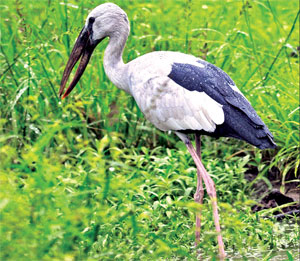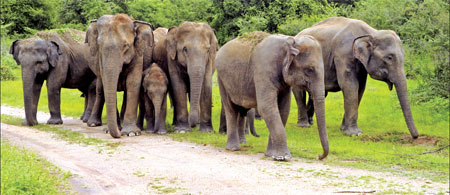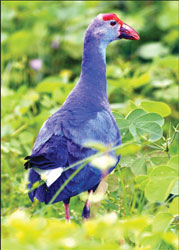|
Wasgamuwa Natural National Park:
A refuge for wild animals

Lesser whistling ducks |

Malabar pied Hornbill |

Asian Openbill |

A large squirrel |

Little Cormorant |
A nature lover's paradise, the Wasgamuwa Natural National Park
located in the Matale and Polonnaruwa Districtsis , is a haven for a
huge variety of fauna and flora in the country. It an impressive natural
park in Sri Lanka covering an extent of 36,948 hectares which was
created as a refuge for the wild life displaced during the Mahaweli
Development Project in 1984.Even though as far back as 1938 this area
was originally designated as a nature reserve it was in 1970 that it was
elevated to the status of a strict nature reserve.
It is popular as one of the parks with the highest biodiversity among
the many protected areas in Sri Lanka.Representing Sri Lanka's dry-zone
dry evergreen forests, the park consists of primary, secondary, riverine
forests and grasslands.
|

A herd of deer |
|

A large herd of elephants |
Apart from the large herd of Marsh elephants (Elephas maximus
vil-aliya)that roam the park freely the other mammals found here include
the purple-faced langur and toque macaque, which are endemic to Sri
Lanka, water buffalo , Sri Lankan Axis deer , leopard, sloth bear and
the golden palm civet. However, the latter three species are rarely
seen.
A large number of bird species too visit the reservoirs and streams
of the national park apart from the birds already living in the park
.About eight of them are endemic species. They include the red-faced
malkoha and the Sri Lanka jungle fowl .The yellow-fronted barbet, Sri
Lanka spurfowl , peafowl, painted stork, black-headed Ibis and Eurasian
spoonbill are the other avian friends that can be seen in the park.There
are many endemic reptiles, amphibians , fish and butterflies too found
in this hot spot of biodiversity believed to contain soil rich in quartz
and marble.
Those of you who have visited this impressive park may be aware that
it is not only one of the best places to see large herds of wild
elephants and other wild life, especially a variety of feathered friends
including the national bird of our nation, but also a place rich in
flora and ancient ruins.
Do you know that the ruins of Malagamuwa, Wilmitiya, Dasthota
irrigation tanks and Kalinga Yoda Ela canal which were built by the
famous King Parakramabahu I can still be seen in the park? The famous
Kandauru Pitiya, a grassland King Dutugemunu's army is believed to have
camped in before the battle with King Elara is also located within the
park in addition to the ruins of Chulangani chaitya which was built by
King Mahanaga . A bowl used by King Sri Vikrama Rajasinha and several
bronze statues have been unearthed from this place along with many other
artefacts. The circumference of the chaitya ruins stands at , 966 feet
(294 m) which is greater than the Ruwanwelisaya.
Facts: Internet
Fast facts
* It is recorded that there are about 23 species of mammal -
including elephants and bears, 143 birds, 8 amphibians, 17 fresh water
fishes, 17 reptiles, 50 butterflies and 150 plants in this park

Purple Swamphen |

Mountain Hawk Eagle |
* The park located in the Central Province , 225 km away from Colombo
is bordered by the 'Mahaweli' and 'Amban' rivers.
* The park is one of the four National Parks designated under the
Mahaweli Project.
* In the past water was irrigated from the Minipe anicut's left bank
canal to Parakrama Samudra by Amban ganga which had run through
Wasgamuwa .
* The circumference of Chulangani chaitya ( built by King Mahanaga) ,
is about 966 feet (294 m) ruins can be seen in the national park .is
greater than the Ruwanwelisaya.
* The name Wasgamuwa has been derived from the words "Walas Gamuwa",
walasa" for sloth bear and gamuwa for wood in Sinhala.
* Wasgamuwa is one of protected areas where Sri Lankan elephants can
be seen in large herds. It is also one of the important bird areas in
Sri Lanka.
* The park has a dry zone climate with an annual daily temperature of
28 degrees Celsius (82degrees F) and annual rainfall ranging between
1650-2100 mm..
* Highest elevation of the park is Sudu Kanda (White mountain), which
is 470 metres (1,540 ft) of height.
*Of the park's 50 butterflies, eight species are endemic. |



